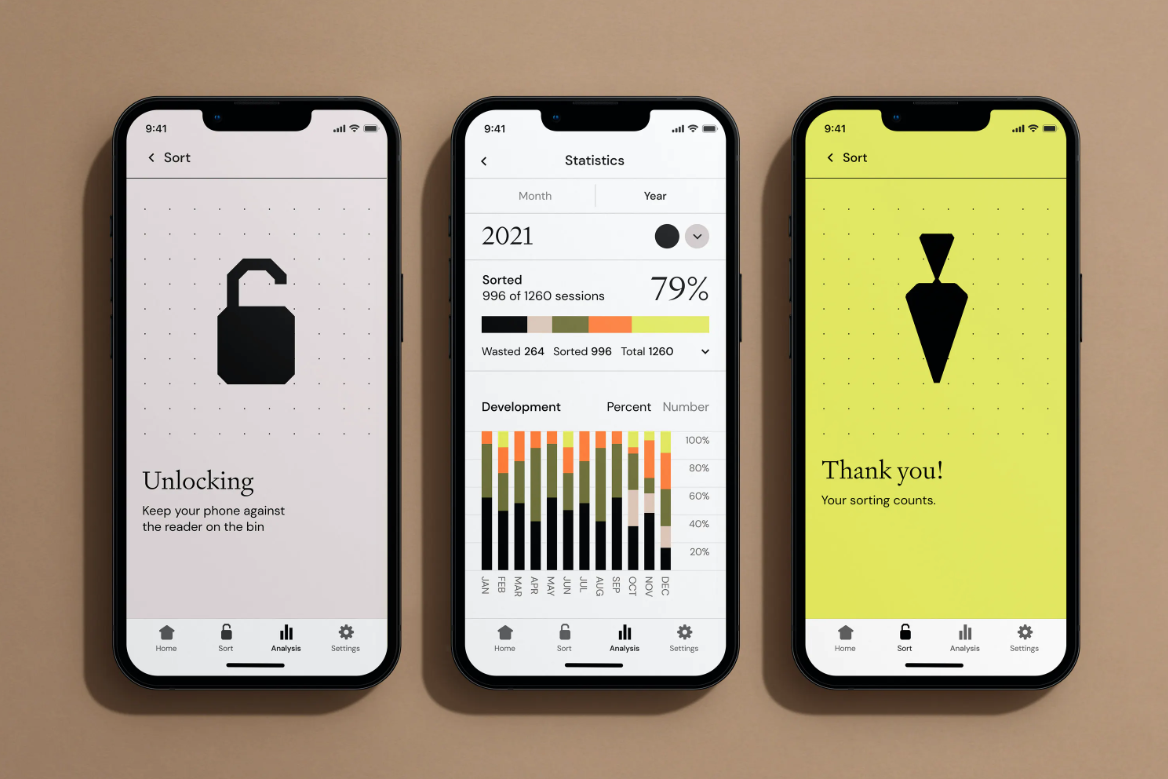PROJECT 5
A Holistic Experience
For better or worse, the earth has now become our canvas and our most interesting system. Designers need to expand our canvases, our outlook on the world, and our plan of action. We are no longer in the business of designing only local products and experiences. We need to aspire much higher if we truly want to have a positive, long-lasting effect on our planet. — Manuel Lima, The New Designer: Rejecting Myths, Embracing Change, 2023.

Carrot, Product Design, 2022.
QUESTIONS
How might you design a product that helps an audience react, learn and/or engage with a current environmental, political and/or social initiative?
LEARNING OUTCOMES-
Developing a product experience from start to finish
- Developing an identity system that coincides with your digital experience
- Research methods in product and identity design
- Exposure to collaborating in teams
- Prototyping a digital experience
INTRODUCTION
In 2023, we are existing in a time where we are (still) living within a global pandemic, being even more so exposed to the cataclysmic impacts of climate change (wildfires), all while living in a time of war (Isreal/Ukraine). Now, this doesn’t even include other important topics like the mental health crisis, education inequality and properly sourced food.
As designers, we react, respond and internalize our current social, political, and health climate whether we like it or not. This isn’t something new, designers have always challenged, critizied and facilitated conversations around these wicked problems with relentless ambition.
Design can’t change the world, however, it can leave a small footprint.
ASSIGNMENT
Based on the topic of social impact that you’ve selected, as a team, you will research, design and develop a product experience that reacts and responds to our current environment.
Your assignment is to come up with a digital service that addresses these changes.
It can be:
-
A new app or service.
-
A new feature for existing services.
-
A new hardware product (smart masks?)
-
New features for existing hardware (alexa, google home, airpods, etc)
-
A digital information campaign.
This will be a group project.
Do your research. If you have an idea, Google it. Find out if it already exists.
Throughout the next five weeks, you will concept, design, and prototype, a final product experience that includes research, user flows, name, identity and any other additional technologies or outputs that deem nessecary.
EXAMPLES
Think of different industries, different audiences, and what has changed for these specific industries over the past few years.
What opportunities are there for chefs? Gym instructors? Teachers? vets? preschools? restaurants? stores? renting? distributed families? long-distance friend groups? people stuck in small apartments by themselves? Elders? People with underlying immune conditions? Medical workers? People who have tested positive? People who need to travel? Protestors? Mutual aid groups/neighborhoods? Dating?
What types of issues are there to solve? What issues exist in mental health? Loneliness? Isolation? Hopelessness? Asynchronous communication? Health? Environment?
CONSIDERATIONS-
How might you focus on a highly specific problem (ie. a mental health experience for teenagers, )
- How does someone interact or engage with your product?
- How might you find a topic of opportunity through research and ideation?
- How might you incorporate new technologies like VR, AR, wearable devices or various softwares?
REQUIREMENTS
Input
The primary use should be a digital product.Process
Show us how someone would use it. Does it work? Test the prototype and update your experience accordingly.Output
How will people find your experience? How will they know what it does? How will they know how it's different than your competitors? Name your experience, create its visual language, and describe it. Think of how it's advertised in the app store, the subway, etc. This should include a name, applications, and a single sentance describing your product.
GROUPS
- Group 1: Seogyeong Kim, Kaia Shin
- Group 2: Yuha Cho, Jen Hong
- Group 3: Bogeum Jung, Kevin Park
- Group 4: Nicole Kim, Inwoo Baek
- Group 5: Hyungjoon Kwon, Shirley Li
- Group 6: Xiaofan Liu, Ashley Kang, Dexter H. Barrett
TOPICS
A set of topics for use but not limited too:
Pollution (ie. IQAir AirVisual)
Mental Health (ie. Headspace)
Climate Change (ie. Earth Now)
Education Inequality (ie exam prep? district locater?
Misinformation, Fake News (ie. Oigetit, Newschecker)
Unsafe Water (ie. Cholora Map)
Food Waste (ie. Carrot, Flashfood)
Income Inequality (ie. mPowering, Atlas of Inequality)
Health Care (ie. Generis)
Crime, Safety (ie. Citizen)
SUGGESTED READINGS
Heydays, Natural aesthetics for health and happiness in brands and digital design, 2022.
Jeff Smith, Design Against Misinformation, 2017.
ADDITIONAL LINKS AND RESOURCES
https://index.goods.no/
https://carrot.tech/
https://goods.no/
https://citizen.com/
https://www.lumi.com/properties
https://www.nikecirculardesign.com/
https://lowimpact.organicbasics.com/eur
https://blackspace.org/
https://solar.lowtechmagazine.com/2018/09/how-to-build-a-lowtech-website/
https://www.calm.com/
https://www.headspace.com/
https://bakkenbaeck.com/case/pafyll
https://bakkenbaeck.com/case/pio
https://bakkenbaeck.com/case/bee-home
https://upstatement.com/case-study/threadable/
https://upstatement.com/case-study/solugen/
https://seed.com/
https://bootcamp.uxdesign.cc/designing-for-fake-news-6c6d8d3e64df
-
https://www.media.mit.edu/groups/fluid-interfaces/overview/
https://bakkenbaeck.com/case/pafyll
https://mill.com/